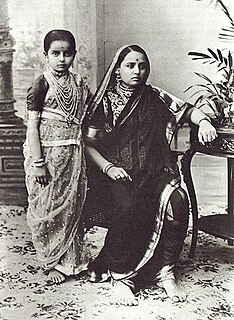
Stockings are close-fitting, variously elastic garments covering the leg from the foot up to the knee or possibly part or all of the thigh. Stockings vary in color, design, and transparency. Today, stockings are primarily worn for fashion and aesthetics, usually in association with mid-length or short skirts.

Pantyhose, called sheer tights in the United Kingdom and a few other countries, are close-fitting legwear covering the wearer's body from the waist to the toes. Mostly considered to be a garment for women and girls, pantyhose first appeared on store shelves in 1959 as a convenient alternative to stockings and/or control panties.

Panties in American English are a form of underwear primarily worn by women. Panties are most often form-fitting, but may also be loose. Typical components include an elastic waistband, a crotch panel to cover the genital area, and a pair of leg openings that, like the waistband, are often made of elastic. Various materials are used, but are usually chosen to be breathable.

A sari, saree or shari is a women's garment from the Indian subcontinent that consists of a drape varying from five to nine yards in length and two to four feet in breadth that is typically wrapped around the waist, with one end draped over the shoulder, baring the midriff. There are various styles sari manufacture and draping, the most common being the Nivi style, which originated in Deccan region of India. The sari is worn with fitted bodice commonly called a choli and petticoat called parkar or ul-pavadai. In the modern Indian subcontinent, the sari is considered a cultural icon.
Long underwear, also called long johns or thermal underwear, is a style of two-piece underwear with long legs and long sleeves that is normally worn during cold weather. It is commonly worn by people under their clothes in cold countries.

Leg warmers are coverings for the lower legs, similar to socks but thicker and generally footless. Leg warmers are worn to keep the lower legs warm in colder weather. They can be tubular sleeves, long fabric wrappings, or simple pieces of fur or fabric tied around the calves. They are used in several outdoor activities and sports including cycling, soccer, hockey, hiking, ice skating, and dance.

Chaps are sturdy coverings for the legs consisting of leggings and a belt. They are buckled on over trousers with the chaps' integrated belt, but unlike trousers they have no seat and are not joined at the crotch. They are designed to provide protection for the legs and are usually made of leather or a leather-like material. Their name is a shortened version of the Spanish word "chaparreras." Chaparreras were named after the chaparral from which they were designed to protect the legs while riding on horseback. Like much of western horse culture the origin of chaparreras was in Nueva España/New Mexico and has been assimilated into cowboy culture of the American west. They are a protective garment to be used when riding a horse through brushy terrain. In the modern world, they are worn for both practical work purposes and for exhibition or show use. Chaps have also been adopted for use on motorcycles, particularly by Harley riders and other cruiser style motorcycle riders.

Boxer briefs are a hybrid type of men's undergarment which are long in the leg, similar to boxer shorts, but tighter-fitting like briefs. Depending on the manufacturer, boxer briefs may also be spelled as one word: boxerbriefs. They are sometimes called "trunks" in the United Kingdom and Australia.

Leggings refer to several types of leg coverings. Modern usage from the 1960s has come to refer to elastic close-fitting garments worn over the legs typically by women, such as leg warmers or tights. Usage from the 18th century refers to men's wear, usually made of cloth or leather that is wrapped around the leg down to the ankle. In the 19th century leggings usually referred to infants' leg clothing that were matched with a jacket, as well as leg-wrappings made of leather or wool and worn by soldiers and trappers. Leggings prominently returned to women's fashion in the 1960s, drawing from the form-fitting clothing of dancers. With the widespread adoption of the synthetic fibre Lycra and the rise in popularity of aerobics, leggings came to further prominence in the 1970s and '80s, and eventually made their way into streetwear. Leggings are a part of the late 2010s athleisure fashion trend of wearing activewear outside sporting activities and in casual settings, which became a contentious social norm in the United States.

The Madisar or Koshavam is a typical way in which the sari is worn by Tamil Brahmin women. The sari and the tying style dates back to ancient India, at least as far back as the period between 2nd century BC to 1st century AD when the antariya and uttariya garments were merged to make a single garment. This style of tying the saree is the "koshavam" style,. Tamil Brahmin women are required to use this style after their marriage. Different communities have evolved different sari styles from the original koshavam style, that requires more material - nine yards. Extant nine-yard sari styles include the nauvari of Maharashtra, the Kannada drape, the Telugu Brahmin style. The name Madisari is however typically associated with Tamil Brahmins, with two sub-styles, the Iyer kattu (tie) and the Iyengar kattu (tie). Today, madisar is hardly worn as daily wear, although women do drape the madisar style on select festive occasions and religious ceremonies. The madisar requires a nine-yard sari to wear it, unlike the current modern version of sari wearing style which needs 6 yards. Both Iyer and Iyengar Brahmins are supposed to wear madisars at ceremonial/ religious occasions, such as the wedding ceremony, the Seemantham, all religious ceremonies, Puja, and death ceremonies.

Gaiters are garments worn over the shoe and lower pants leg, and used primarily as personal protective equipment; similar garments used primarily for display are spats. Originally, gaiters were made of leather. Today, gaiters for walking are commonly made of plasticized synthetic cloth such as polyester. Gaiters for use on horseback continue to be made of leather.
Churidars, or more properly churidar pyjamas, are tightly fitting trousers worn by both men and women in the Indian subcontinent. Churidars are a variant of the common shalwar pants. Salwars are cut wide at the top and narrow at the ankle. Churidars narrow more quickly, so that contours of the leg are revealed. They are usually cut on the bias, making them naturally stretchy. Stretch is important when pants are closefitting. They are also longer than the leg and sometimes finish with a tightly fitting buttoned cuff at the ankle. The excess length falls into folds and appears like a set of bangles resting on the ankle. When the wearer is sitting, the extra material is the "ease" that makes it possible to bend the legs and sit comfortably. The word churidar is from Urdu and made its way into English only in the 20th century. Earlier, tight fitting churidar-like pants worn in India were referred to by the British as Moghul breeches, long-drawers, or mosquito drawers.
Pettipants are a type of lingerie worn by women. The name is a portmanteau of petticoat and pants. Pettipants are similar to long shorts, though they may be made from material such as cotton and lace, and usually have ruffles down each leg. They are available in different lengths up to knee length.
Telogreika or vatnik is a Russian kind of warm cotton wool-padded jacket. It was also a part of winter uniform first issued by the Red Army during World War II. Telogreikas continued to be issued until the late 1960s.

The preservation of fabric fibers and leathers allows for insights into the attire of ancient societies. The clothing used in the ancient world reflects the technologies that these peoples mastered. In many cultures, clothing indicated the social status of various members of society.

Gagra choli or ghagra choli, which is also known as lehenga choli and locally as chaniya choli, is the traditional clothing of women from the Indian subcontinent, notable in Indian states of Rajasthan, Gujarat, Maharashtra, Madhya Pradesh, Uttar Pradesh, Bihar, Haryana, Punjab, Himachal Pradesh, Uttarakhand, Jammu, as well as in Nepal. In Punjab it was traditionally worn with the kurti and salwar. In Maharashtra it is traditionally called as Parkar Polka It is a combination of the gagra or lehenga and the choli (blouse).

History of clothing in the Indian subcontinent can be traced to the Indus Valley Civilization or earlier. Indians have mainly worn clothing made up of locally grown cotton. India was one of the first places where cotton was cultivated and used even as early as 2500 BCE during the Harappan era. The remnants of the ancient Indian clothing can be found in the figurines discovered from the sites near the Indus Valley Civilisation, the rock-cut sculptures, the cave paintings, and human art forms found in temples and monuments. These scriptures view the figures of human wearing the clothes which can be wrapped around the body. Taking the instances of the sari to that of turban and the dhoti, the traditional Indian wears were mostly tied around the body in various ways. The clothing system was also related to the social and economic status of the person. The upper classes of the society wore fine muslin garments and silk fabrics while the common classes wore garments made up of locally made fabrics. For instance, women from rich families wore clothes made up of silk from China, but the common women wore sari made up of cotton or local fabrics. The Indus civilisation knew the process of silk production. Recent analysis of Harappan silk fibers in beads have shown that silk was made by the process of reeling, the art known only to China till the early centuries AD.
Midway briefs are a hybrid type of men's undergarment which are longer in the leg than boxer briefs and tighter-fitting, like briefs.


















